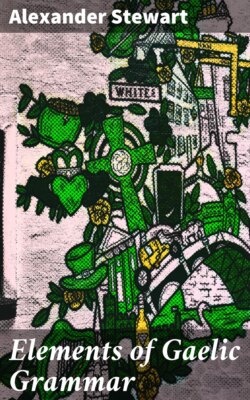Читать книгу Elements of Gaelic Grammar - Alexander Stewart - Страница 8
На сайте Литреса книга снята с продажи.
PART I.
ОглавлениеTable of Contents
OF PRONUNCIATION AND ORTHOGRAPHY.
The Gaelic alphabet consists of eighteen letters: a, b, c, d, e, f, g, h, i, l, m, n, o, p, r, s, t, u. Of these, five are vowels, a, e, i, o, u; the rest consonants.
In explaining the powers of the letters, and of their several combinations, such obstacles lie in the way that complete success is not to be expected. In order to explain, in writing, the sounds of a particular language, the only obvious method is to represent them by the letters commonly employed to exhibit similar sounds in some well-known living language. But there are sounds in the Gaelic to which there are none perfectly similar in English, nor perhaps in any modern European tongue. Besides, the same combination of letters does not invariably represent the same sound in one age that it did in a former, or that it may do in the next. And this may be equally true of the letters of the Gaelic alphabet, whose powers are to be taught; and of the letters of any other language, by whose sounds the powers of the former are to be explained. A diversity of pronunciation is very distinguishable also in different districts of the Highlands of Scotland, even in uttering the same words written in the same manner. Though the powers of the letters, then, may be explained to a certain degree of accuracy, yet much will still remain to be learned by the information of the ear alone.
Although the chief use of the vowels be to represent the vocal sounds of speech, and that of the consonants to represent its articulations, yet, as in many languages, so in Gaelic, the consonants sometimes serve to modify the sound of the vowels with which they are combined; while, on the other hand, the vowels often qualify the sound of the consonants by which they are preceded or followed.
It may not appear obvious at first sight how a vowel should be employed, not to represent a vocal sound, but to modify an articulation. Yet examples are to be found in modern languages. Thus, in the English words, George, sergeant, the e has no other effect than to give g its soft sound; and in guest, guide, the u only serves to give g its hard sound. So in the Italian words giorno, giusto, and many others, the i only qualifies the sound of the preceding consonant. The same use of the vowels will be seen to take place frequently in Gaelic orthography.
Besides the common division of the letters into Vowels and Consonants, it is found convenient to adopt some further subdivisions.
The Vowels are divided into broad and small: a, o, u, are called broad vowels; e, i, small vowels.
The Consonants are divided into Mutes and Liquids: Mutes, b, c, d, f, g, m, p, t; Liquids, l, n, r, s[3]. They are also divided into Labials, Palatals, and Linguals, so named from the organs employed in pronouncing them: Labials, b, f, m, p; Palatals, c, g; Linguals, d, l, n, r, s, t.
The aspirate h is not included in any of these divisions[4].
OF THE SOUNDS OF THE VOWELS[5].
All the vowels are sometimes long, sometimes short. A long vowel is often marked with an accent, especially when the quantity of the vowel determines the meaning of the word; as, bàs death, sàil the heel, càraid a pair, rìs again, mò more, lòn a marsh; which are distinguished by the accent alone from bas the palm of the hand, sail a beam, caraid a friend, ris to, lon the elk.
All the vowels, but especially the broad ones, have somewhat of a nasal sound when preceded or followed by m, mh, n, nn. No vowels are doubled in the same syllable like ee, oo, in English.
In almost all polysyllables, excepting some words compounded with a preposition, the accent falls on the first syllable[6]. The other syllables are short and unaccented, and the vowels in that situation have in general the same short obscure sound. Hence it happens that the broad vowels in these syllables are often used indiscriminately.
There are no quiescent final vowels.
